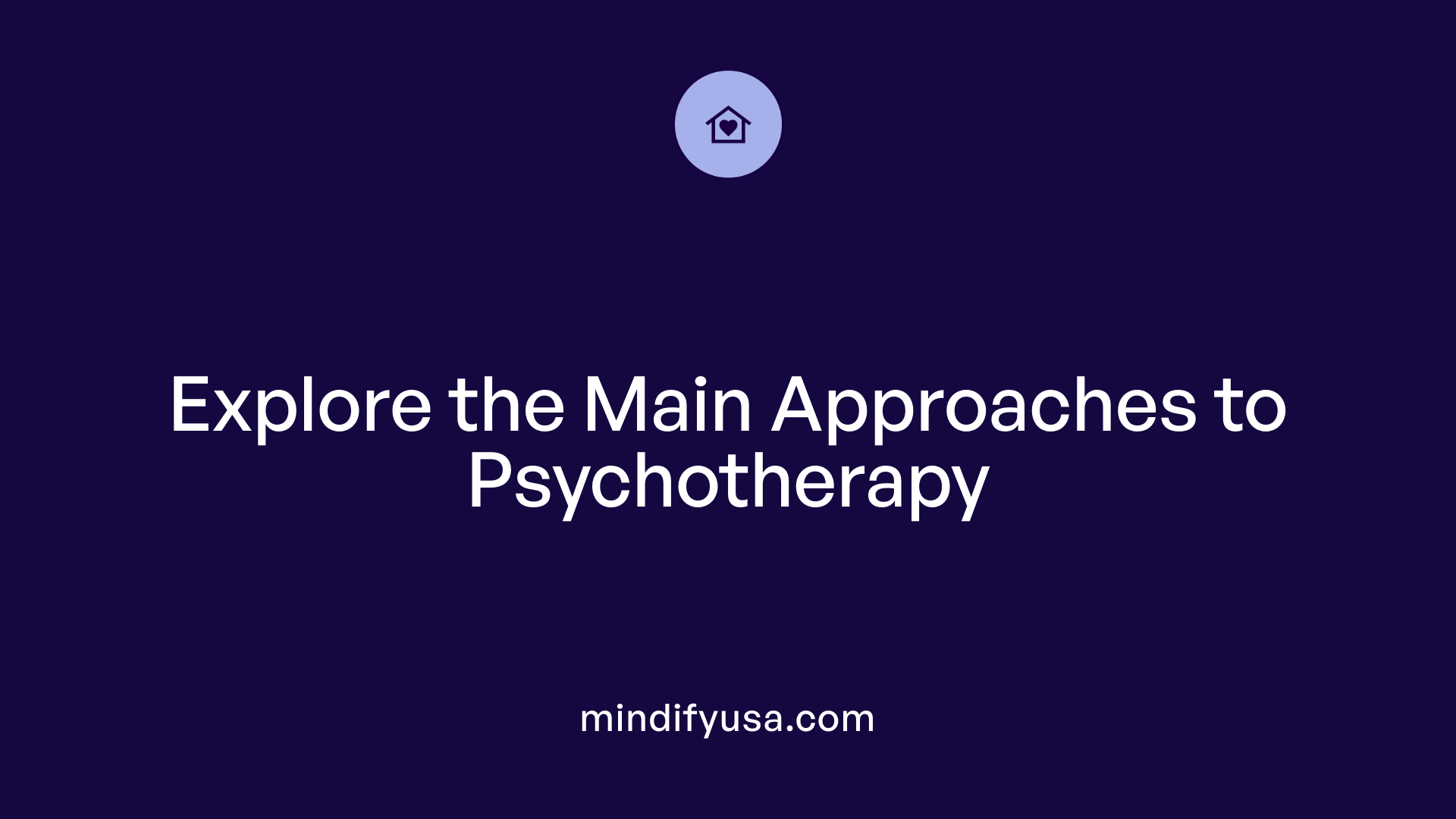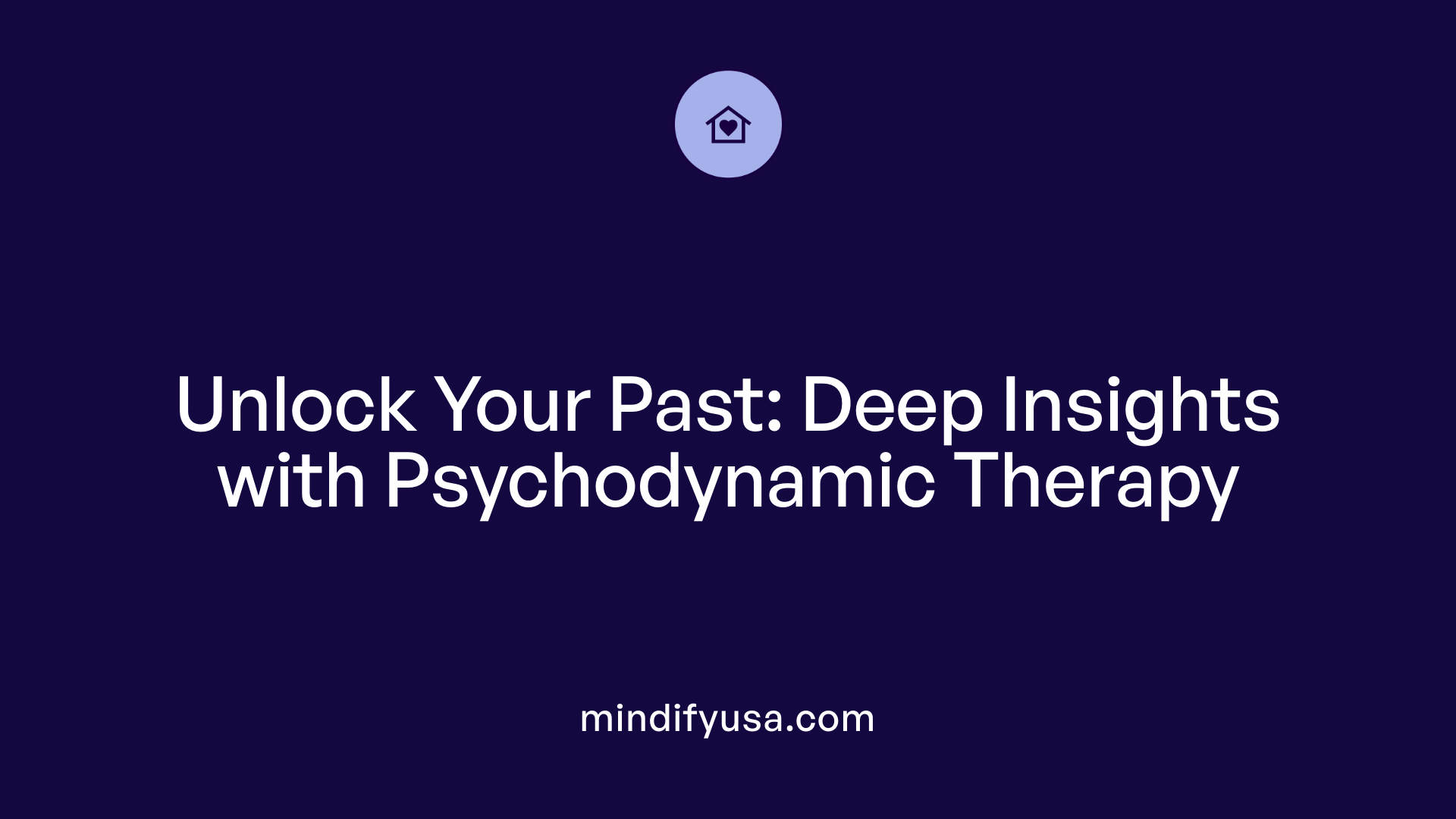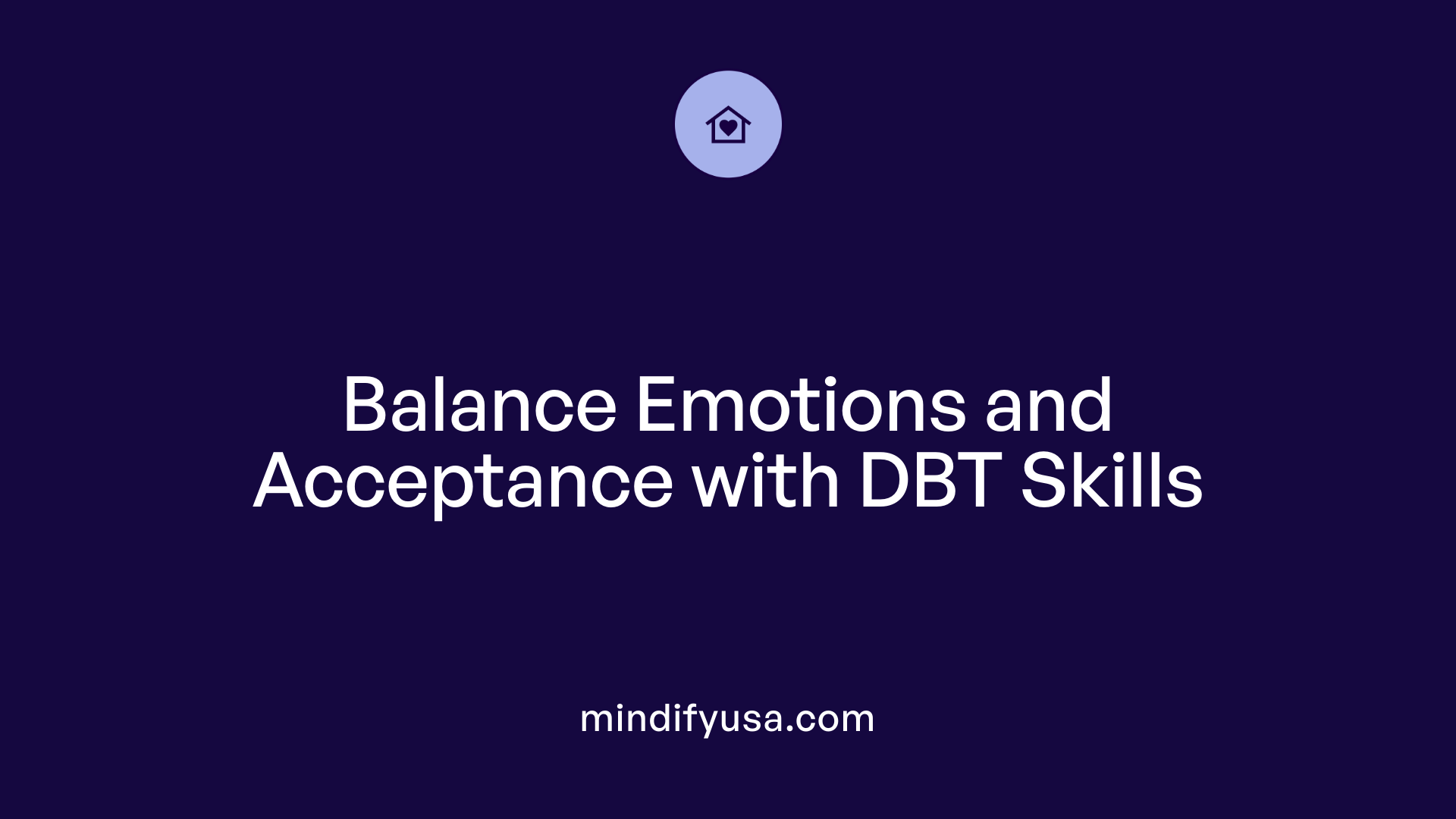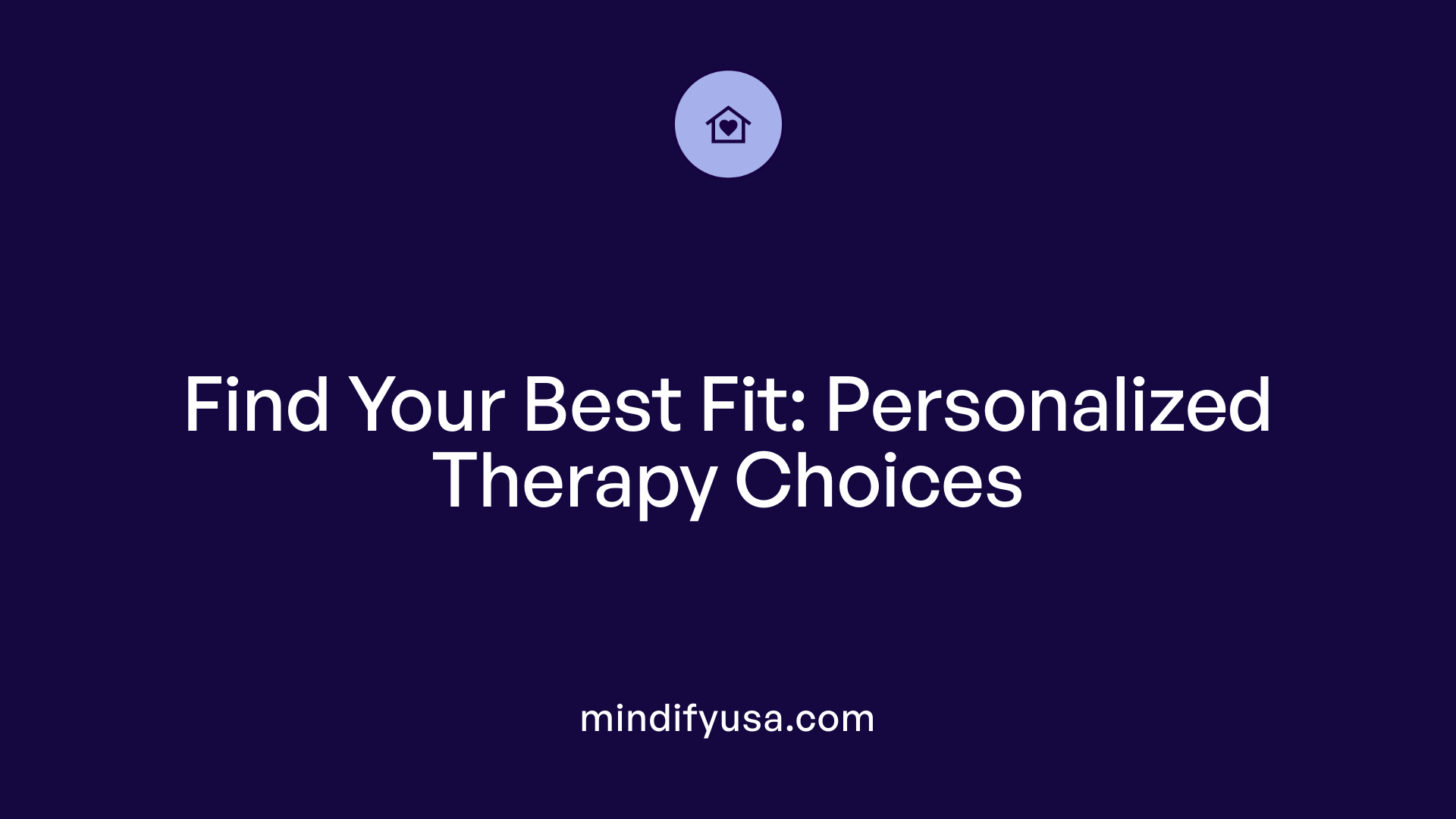Exploring Major Therapeutic Approaches for Mental Health
The field of psychotherapy encompasses various approaches, each tailored to address different aspects of emotional, cognitive, and behavioral challenges. From exploring unconscious motivations to developing practical coping skills, understanding the diverse methods available can help individuals choose the most suitable treatment options for their mental health concerns.
Main Types of Psychotherapy

What are the main types of psychotherapy?
Psychotherapy encompasses a broad spectrum of treatment approaches aimed at improving mental health and emotional wellbeing. The primary categories include psychoanalysis and psychodynamic therapies, behavior therapy, cognitive therapy, humanistic therapy, and integrative techniques.
Psychoanalytic and psychodynamic therapies delve into unconscious motives, childhood influences, and past experiences to uncover the root causes of current issues. These approaches often involve longer-term work and open-ended exploration. Behavior therapy, on the other hand, is rooted in learning principles like classical and operant conditioning, emphasizing observable behavioral change without focusing extensively on underlying thoughts or feelings.
Cognitive therapy, including Cognitive Behavioral Therapy (CBT), concentrates on identifying and changing dysfunctional thoughts that contribute to emotional distress. Humanistic therapies prioritize personal growth, self-awareness, and acceptance, fostering an understanding of oneself and one's experiences.
Additionally, there are specialized interventions like Dialectical Behavior Therapy (DBT), which combines elements of CBT with mindfulness and emotional regulation skill-building, often used for intense emotional difficulties. Interpersonal Therapy (IPT) primarily targets relationship issues contributing to depression and other mood disorders. Many therapies now incorporate elements from multiple approaches to construct personalized treatment plans suited to individual needs.
Focus areas of each main category
| Therapy Type | Main Focus | Typical Duration | Target Conditions | Notable Techniques |
|---|---|---|---|---|
| Psychoanalysis/ Psychodynamic | Unconscious motives, childhood influences | Long-term, often months/years | Depression, Anxiety, Personality Disorders | Free association, dream analysis |
| Behavior Therapy | Changing actions and habits | Short-term, 5-20 sessions | Phobias, OCD, substance abuse | Systematic desensitization, flooding |
| Cognitive Therapy (CBT) | Thought patterns, beliefs | 5-20 sessions | Depression, Anxiety, Eating Disorders | Thought records, behavioral experiments |
| Humanistic Therapy | Self-awareness, personal growth | Variable, client-led | Depression, Trauma, Self-esteem issues | Client-centered approach, Gestalt techniques |
| Dialectical Behavior Therapy (DBT) | Emotional regulation, mindfulness | 6 months to 1 year | Borderline Personality Disorder, Self-harm | Mindfulness, distress tolerance |
Examples of specific therapies within each category
- Psychoanalytic/Psychodynamic: Classic psychoanalysis, short-term psychodynamic therapy, mentalization-based therapy (MBT).
- Behavioral: Systematic desensitization for phobias, aversion therapy for unwanted behaviors, flooding for intense anxiety.
- Cognitive: Rational Emotive Behavior Therapy (REBT), Acceptance and Commitment Therapy (ACT), mindfulness-based interventions.
- Humanistic: Client-centered therapy, Gestalt therapy, existential therapy.
- Other specialized approaches: Eye Movement Desensitization and Reprocessing (EMDR) for trauma, Solution-focused brief therapy (SFBT), group therapy, family therapy.
Understanding the distinct motivations, techniques, and goals of each approach can assist individuals in selecting a form of therapy that aligns with their personal circumstances and mental health objectives. Consulting a mental health professional ensures the most suitable method is chosen to support recovery and personal growth.
Understanding Psychodynamic Therapy: Exploring Deep Causes of Emotional Distress

What are the main types of psychotherapy?
Psychotherapy encompasses various approaches aimed at improving mental health and emotional well-being. A fundamental category is psychodynamic therapy, derived from psychoanalysis. It is a long-term treatment that delves into unconscious drives, childhood experiences, and recurring patterns to reveal the root causes of emotional distress.
Other prominent types include cognitive behavioral therapy (CBT), which is structured and short-term, focusing on changing negative thoughts and behaviors. Dialectical behavior therapy (DBT), initially developed for borderline personality disorder, emphasizes mindfulness and emotional regulation. Each type targets different needs and employs unique techniques, but all aim to foster psychological health.
Focus on unconscious processes, childhood experiences, and patterns
Psychodynamic therapy pays particular attention to how unconscious drives and past experiences influence current behavior. It explores childhood experiences, relationships, and recurring dreams to identify underlying conflicts. This approach assumes that unresolved issues from the past continue to shape feelings and actions in adult life.
Therapists encourage clients to freely express thoughts, fears, and memories, facilitating insight into how these unconscious factors contribute to problems like depression, anxiety, and relationship difficulties. Recognizing ongoing patterns helps individuals understand the origins of their emotional struggles.
Typical duration and imagery used in therapy
Psychodynamic therapy usually involves longer-term engagement, often spanning several months or even years, with weekly sessions. The open-ended, exploratory nature allows deep insight to develop over time.
In therapy, imagery such as recurring dreams or symbolic representations is often discussed. Dreams serve as a window into unconscious content, revealing hidden fears, desires, and conflicts. Therapists and clients work together to interpret these images, facilitating emotional understanding and resolution.
Conditions treated and therapeutic goals
This form of therapy is particularly effective for depression, anxiety, personality disorders, and relational problems. Its primary goal is to enhance self-awareness by uncovering unconscious influences rooted in childhood and past experiences.
By gaining insight into these underlying factors, individuals can resolve internal conflicts, reduce symptoms, and achieve emotional growth. Psychodynamic therapy aims to foster profound and lasting change through understanding oneself more deeply.
| Therapy Aspect | Description | Typical Duration | Focus |
|---|---|---|---|
| Main Type | Psychodynamic / Psychoanalysis | Several months to years | Unconscious drives, childhood, patterns |
| Techniques | Free association, dream analysis, exploring emotions | Weekly sessions | Insight, emotional healing, conflict resolution |
| Goals | Self-awareness, resolving conflicts, understanding origins of distress | Long-term | Emotional insight, behavioral change |
This comprehensive approach helps individuals uncover the roots of their emotional issues, leading to transformation and resilience that often long outlast the therapy itself.
Behavioral Therapy: Modifying Actions for Better Outcomes

Overview of behavioral therapy and its focus on actions.
Behavioral therapy is a well-established form of psychotherapy that centers on changing problematic behaviors through practical, action-based techniques. Unlike therapies that delve into unconscious thoughts or past experiences, behavioral therapy emphasizes observable behaviors and the learning processes that influence them.
This approach is grounded in behavioral psychology principles such as classical conditioning, operant conditioning, and exposure techniques. Its main goal is to help individuals replace maladaptive behaviors with healthier, more adaptive responses. Because of its focus on direct action, behavioral therapy is often seen as a short-term, goal-oriented treatment.
What are the main types of psychotherapy?
Behavioral therapy is distinguished by its action-oriented methods. It involves techniques designed to modify specific behaviors rather than explore underlying psychological causes.
Types of behavioral therapy include:
- Systematic Desensitization: A gradual exposure method used to help individuals overcome fears and phobias. It pairs relaxation techniques with controlled exposure to anxiety-provoking stimuli.
- Aversion Therapy: Associates undesirable behaviors with discomfort or unpleasant stimuli to discourage their occurrence, often used in cases like substance abuse.
- Flooding: Involves immediate and intense exposure to a feared object or situation to reduce anxiety responses through extinction.
These techniques aim to produce swift and measurable changes, making behavioral therapy particularly suitable for conditions like phobias, OCD, and certain behavioral problems.
How do therapies like CBT, DBT, and psychodynamic therapy differ in their approaches?
While behavioral therapy focuses on changing behaviors directly, other therapies have different focal points:
| Therapy Type | Approach | Focus | Typical Duration | Main Techniques |
|---|---|---|---|---|
| CBT | Combines behavioral and cognitive strategies | Thought patterns and behaviors | Short-term (12-20 sessions) | Thought restructuring, exposure, skill training |
| DBT | Incorporates mindfulness with behavioral methods | Emotion regulation and interpersonal skills | Usually longer-term | Mindfulness, distress tolerance, emotional regulation |
| Psychodynamic | Explores unconscious motives and past experiences | Unconscious conflicts and childhood influences | Longer-term | Free association, dream analysis, transference |
Behavioral therapy typically shifts focus away from internal psychological conflicts towards external observable behaviors and responses. It complements approaches like CBT and DBT but remains distinct in its emphasis on action and reinforcement.
What are the indications and goals of various psychotherapy approaches?
Each psychotherapy modality targets specific needs and involves tailored goals:
| Therapy Approach | Indications | Goals | Techniques |
|---|---|---|---|
| Behavioral Therapy | Phobias, OCD, substance abuse, ADHD, behavioral issues | Replace maladaptive behaviors with healthier responses | Exposure, reinforcement, timeout |
| Cognitive Behavioral Therapy (CBT) | Depression, anxiety, mood disorders, OCD, eating disorders | Identify and modify distorted thinking and behaviors | Cognitive restructuring, homework assignments |
| Dialectical Behavior Therapy (DBT) | Borderline personality disorder, self-harm, emotional dysregulation | Improve emotional regulation, interpersonal effectiveness | Mindfulness, distress tolerance |
| Psychodynamic Therapy | Depression, anxiety, trauma, personality disorders | Insight into unconscious conflicts and past influences | Exploring childhood, transference |
The common aim across these approaches is symptom relief and improved functioning, often through developing coping skills and emotional awareness.
How can one determine which type of therapy is suitable for them?
Choosing an appropriate therapy depends on the individual’s specific issues, preferences, and treatment goals.
For instance, those dealing with specific fears, phobias, or behavioral addictions might benefit most from behavioral therapy techniques like exposure or reinforcement.
A mental health professional can evaluate the nature of the problem—such as whether symptoms are primarily behavioral, emotional, or rooted in unconscious conflicts—and recommend the most suitable approach.
People seeking immediate behavioral change, quick symptom relief, or struggling with compulsive behaviors often prefer action-based therapies.
What are the benefits of engaging in therapy?
Engaging in therapy offers several advantages:
- Rapid improvements in targeted behaviors especially with structured techniques.
- Development of coping and self-control skills.
- Clear progress indicators that motivate ongoing effort.
- Reduced symptoms of anxiety, depression, and phobias.
- Enhanced problem-solving abilities.
- Increased self-awareness and emotional regulation.
Overall, behavioral therapy provides practical tools that can be incorporated into daily life to maintain long-term mental health benefits.
| Aspect | Details | Additional Notes |
|---|---|---|
| Main Focus | Changing behaviors through action | Emphasizes learning principles |
| Techniques Used | Exposure, reinforcement, desensitization | Designed to produce quick results |
| Conditions Treated | Phobias, OCD, substance use, ADHD | Suitable for specific behavioral problems |
| Duration | Variable, often short-term | 4 to 20 sessions typical |
| Benefits | Rapid progress, skill development | Clear measurable outcomes |
This overview highlights the varied approaches within behavioral therapy and its applications, emphasizing how targeted behavioral change can substantially improve mental health.
Cognitive Behavioral Therapy (CBT): Practical Strategies for Mental Well-being
What are the main types of psychotherapy?
Cognitive Behavioral Therapy (CBT), created by Dr. Aaron Beck, is a short-term, structured, goal-focused psychotherapy. Its core idea is that our thoughts, feelings, and behaviors are interconnected. By recognizing and modifying unhelpful thoughts, clients can experience improvements in their emotional state and behavior.
CBT focuses on identifying 'cognitive distortions' such as catastrophizing, overgeneralization, or all-or-nothing thinking. Once these patterns are identified, therapists guide individuals to replace distorted thoughts with more realistic and balanced ones.
Throughout the therapy, practical techniques like cognitive restructuring, behavioral activation, and homework tasks play vital roles. These strategies help reinforce learning, change maladaptive behaviors, and develop coping skills.
How do therapies like CBT, DBT, and psychodynamic therapy differ in their approaches?
CBT primarily emphasizes tackling present-focused thoughts and behaviors with a structured, directive approach. It aims for quick, tangible change and teaching clients practical skills.
Psychodynamic therapy, however, looks deeper into unconscious motives, childhood experiences, and emotional conflicts that influence current behavior. It typically involves longer-term exploration of past relationships and unresolved conflicts.
DBT, or Dialectical Behavior Therapy, integrates CBT techniques with mindfulness, emotional regulation, and interpersonal skills. It was specifically developed for BPD but is useful for managing intense emotions and relationship problems.
Each therapy offers a different lens: CBT is practical and skills-based, psychodynamic is insight-oriented, and DBT combines the two with an emphasis on acceptance and validation.
What are the indications and goals of various psychotherapy approaches?
CBT is highly effective for mental health conditions like depression, anxiety, OCD, bipolar disorder, eating disorders, and some symptoms of schizophrenia. Its main goal is to help clients recognize distorted thinking patterns, reduce maladaptive behaviors, and develop more adaptive emotional responses.
Other therapies target specific issues as well. For example, psychodynamic therapy aims to resolve deep-seated emotional conflicts rooted in childhood, aiding long-term personality change. DBT focuses on managing intense emotions, reducing self-harm, and improving interpersonal functioning.
Overall, the primary aim across all therapies is to improve mental health and quality of life by addressing underlying thoughts, feelings, and behaviors.
How can one determine which type of therapy is suitable for them?
Choosing a therapy depends on individual needs, preferences, and specific issues. Those seeking a structured, action-oriented approach that delivers quick coping skills may prefer CBT.
A mental health professional can evaluate a person’s symptoms, history, and learning style to recommend the most suitable approach. For instance, those with deep-rooted emotional conflicts or personality issues might benefit from psychodynamic therapy, while individuals with intense emotional regulation difficulties may find DBT more helpful.
It’s also essential to consider the treatment goals, time commitments, and personal comfort with different therapy styles.
What are the benefits of engaging in therapy?
Engaging in therapy provides numerous benefits. CBT offers practical tools and coping strategies that patients can apply immediately in daily life.
Research supports its effectiveness in reducing symptom severity in conditions like depression, anxiety, OCD, and bipolar disorder. It enhances problem-solving skills, emotional regulation, and resilience.
Beyond symptom reduction, therapy can improve self-awareness, relationships, and overall well-being. Many find it empowering to understand their thoughts and feelings better and develop healthier habits.
In summary, therapy is a valuable investment in mental health, offering both immediate relief and long-term resilience through evidence-based practices and personalized support.
Dialectical Behavior Therapy (DBT): Skills for Managing Emotions and Relationships

What are the main types of psychotherapy?
Dialectical Behavior Therapy (DBT) is a specialized form of therapy initially designed to treat borderline personality disorder (BPD). It integrates various techniques, including mindfulness, distress tolerance, emotional regulation, and interpersonal effectiveness. DBT emphasizes balancing acceptance of difficult emotions with the motivation to change, making it highly effective for managing mood disorders, self-harm, substance abuse, and other intense emotional challenges.
How do therapies like CBT, DBT, and psychodynamic therapy differ in their approaches?
Cognitive Behavioral Therapy (CBT) primarily focuses on identifying and changing unhelpful thought patterns and behaviors through structured, skill-based interventions. Psychodynamic therapy explores unconscious motives, childhood experiences, and unresolved conflicts to understand current behavior.
DBT extends CBT by adding mindfulness and acceptance components. It specifically targets emotional dysregulation and interpersonal problems with pragmatic skills training. While psychodynamic therapy seeks insight into unconscious processes over longer periods, DBT emphasizes immediate skills for emotional control and relationship management.
What are the indications and goals of various psychotherapy approaches?
DBT is mainly indicated for borderline personality disorder, self-harm behaviors, and difficulties with emotional regulation. Its goals include fostering mindfulness, emotional resilience, and effective communication. It aims to reduce self-destructive behaviors, promote acceptance of emotional pain, and build a foundation for meaningful change.
Other therapies serve different aims. For example, CBT targets depression and anxiety by restructuring negative thoughts, while psychodynamic therapy seeks insight into unconscious influences for long-term emotional healing. Each approach aligns with specific conditions and personal goals.
How can one determine which type of therapy is suitable for them?
Choosing the right therapy depends on individual needs. Those experiencing intense emotions, relationship struggles, or self-harm tendencies might benefit most from DBT, especially if they seek practical skills for managing emotions and relationships.
Assessing personal treatment goals, preferences for structured skills training, and willingness to explore unconscious issues can guide this decision. Consulting a mental health professional for a comprehensive evaluation helps ensure the selected therapy fits individual circumstances.
What are the benefits of engaging in therapy?
Engaging in DBT offers numerous benefits, including improved emotional regulation, better control over mood swings, and healthier interpersonal relationships. It reduces harmful behaviors like self-injury and substance misuse.
Participants often report increased resilience, clarity about their emotions, and a greater sense of acceptance and self-compassion. Overall, DBT promotes a balanced approach to emotional challenges, enriching quality of life through tailored acceptance and active change skills.
Choosing the Right Therapy: Tailoring Treatment to Personal Needs

Factors to consider in selecting a therapy
Choosing the appropriate therapy depends on understanding one's personal needs, the nature of their mental health issues, and their preferences for treatment style. For example, if someone struggles with deep unconscious conflicts or past experiences, psychodynamic therapy might be beneficial. Conversely, those seeking quicker symptom relief, especially for anxiety or depression, might consider cognitive behavioral therapy (CBT). The structure of therapy, whether long-term or short-term, and the setting—individual, group, or online—also play important roles.
Additionally, the severity and type of symptoms influence therapy choice. Conditions like borderline personality disorder may respond well to dialectical behavior therapy (DBT), while trauma-related disorders often benefit from Eye Movement Desensitization and Reprocessing (EMDR). Personal comfort with the therapist’s approach, cultural considerations, and logistics such as session frequency and cost are also factors to evaluate.
Importance of professional guidance and compatibility
Consulting a mental health professional is crucial in making an informed decision. A qualified therapist can assess an individual’s specific circumstances and recommend a suitable approach. Building a good rapport with the therapist—feeling safe, understood, and respected—is essential for effective treatment.
Therapists use their expertise not only to diagnose issues but also to help clients understand their options. They can adapt treatment plans to suit evolving needs and ensure that the therapy aligns with the client’s goals. Feeling comfortable with the therapist’s style—whether more structured like CBT or open-ended like psychodynamic therapy—can significantly influence outcomes.
Personal preferences and specific conditions
Each person’s preferences—such as preferences for talking versus activities, formal versus relaxed settings, or incorporating mindfulness—should guide therapy selection. For example, someone interested in holistic approaches might favor therapies like mindfulness-based cognitive therapy (MBCT) or acceptance and commitment therapy (ACT). Individuals with trauma histories might find EMDR particularly helpful.
Specific conditions, such as OCD, may require targeted therapies like exposure therapy combined with CBT, while relationship issues may benefit from couples or interpersonal therapy. Those seeking personal growth and self-awareness might opt for humanistic therapies or expressive arts therapy.
To maximize benefits, it’s recommended to start with an initial consultation, during which the therapist can help determine the most suitable approach based on the individual’s unique situation.
| Consideration Aspect | Therapy Types | Suitable Conditions | Additional Notes |
|---|---|---|---|
| Problem Focus | CBT, Exposure therapy, SFBT | Anxiety, OCD, phobias | Short-term, goal-oriented |
| Emotional Depth | Psychodynamic, IPT | Depression, personality disorders | Longer-term, insight-focused |
| Emotional Regulation | DBT, MBCT | BPD, mood swings, stress | Skills training included |
| Self-Development | Humanistic, Gestalt, Art therapy | Personal growth, trauma | Focus on self-awareness |
| Trauma & PTSD | EMDR, TF-CBT | PTSD from trauma | Specific trauma processing methods |
Understanding personal needs and maintaining open communication with professionals helps in choosing a therapy that fits the individual’s journey toward mental well-being.
Embracing a Holistic View of Mental Health Treatments
Understanding the wide array of psychotherapy options—from psychodynamic insights to skill-based therapies like CBT and DBT—empowers individuals to make informed decisions about their mental health journey. Each approach offers unique benefits and caters to different needs, whether seeking deep emotional understanding or practical coping mechanisms. Collaborating with qualified mental health professionals to choose and tailor the right therapy can greatly enhance personal growth, emotional resilience, and overall well-being, paving the way for a healthier, more balanced life.





































































































